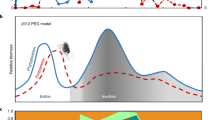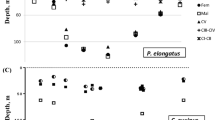Abstract
Competition theory predicts that population fluctuations can promote genetic diversity when combined with density-dependent selection1,2. However, this stabilizing mechanism has rarely been tested, and was recently rejected as an explanation for maintaining diversity in natural populations of the freshwater herbivore Daphnia pulex3. The primary limitation of competition theory is its failure to account for the alternative types of population cycles that are caused by size- or stage-dependent population vital rates—even though such structure both explains the fluctuating dynamics of many species4 and may alter the outcome of competition5. Here we provide the first experimental test of whether alternative types of cycles affect natural selection in predator–prey systems. Using competing Daphnia genotypes, we show that internally generated, stage-structured cycles substantially reduce the magnitude of selection (thereby contributing to the maintenance of genetic diversity), whereas externally forced cycles show rapid competitive exclusion. The change in selection is ecologically significant, spanning the observed range in natural populations3. We argue that structured cycles reduce selection through a combination of stalled juvenile development and stage-specific mortality. This potentially general fitness-equalizing mechanism may reduce the need for strong stabilizing mechanisms to explain the maintenance of genetic diversity in natural systems.
This is a preview of subscription content, access via your institution
Access options
Subscribe to this journal
Receive 51 print issues and online access
$199.00 per year
only $3.90 per issue
Buy this article
- Purchase on Springer Link
- Instant access to full article PDF
Prices may be subject to local taxes which are calculated during checkout




Similar content being viewed by others
References
Armstrong, R. A. & McGehee, R. Competitive exclusion. Am. Nat. 115, 151–170 (1980)
Huisman, J. & Weissing, F. J. Biodiversity of plankton by species oscillations and chaos. Nature 402, 407–410 (1999)
Nelson, W. A. Competition in Structured Zooplankton Populations: Coupling Population Genetics and Dynamics Using Theoretical and Experimental Approaches. Ph.D. Thesis, Univ. Calgary (2004)
Murdoch, W. W. et al. Single-species models for many-species food webs. Nature 417, 541–543 (2002)
de Roos, A. M., Persson, L. & McCauley, E. The influence of size-dependent life-history traits on the structure and dynamics of populations and communities. Ecol. Lett. 6, 473–487 (2003)
Lynch, M. The limits to life history evolution in Daphnia . Evolution 38, 465–482 (1984)
Lynch, M. The consequences of fluctuating selection for isozyme polymorphisms in Daphnia . Genetics 115, 657–669 (1987)
Mort, M. A. Bridging the gap between ecology and genetics: the case of freshwater zooplankton. Trends Ecol. Evol. 6, 41–45 (1991)
Dufresne, F. & Hebert, P. D. N. Polyploidy and clonal diversity in an arctic cladoceran. Heredity 75, 45–53 (1995)
Hebert, P. D. N. & Crease, T. J. Clonal diversity in populations of Daphnia pulex reproducing by obligate parthenogenesis. Heredity 51, 353–369 (1983)
Weider, L. J. Spatial and temporal genetic heterogeneity in a natural Daphnia population. J. Plankton Res. 7, 101–123 (1985)
Hebert, P. D. N. Niche overlap among species in the Daphnia carinata complex. J. Anim. Ecol. 46, 399–409 (1977)
Loaring, J. M. & Hebert, P. D. N. Ecological differences among clones of Daphnia pulex Leydig. Oecologia 51, 162–168 (1981)
Hebert, P. D. N. & Crease, T. J. Clonal coexistence in Daphnia pulex (Leydig): another planktonic paradox. Science 207, 1363–1365 (1980)
Hardin, G. The competitive exclusion principle. Science 131, 1292–1298 (1960)
Chesson, P. Mechanisms of maintenance of species diversity. Annu. Rev. Ecol. Syst. 31, 334–366 (2000)
de Roos, A. M. & Persson, L. Competition in size-structured populations, mechanisms inducing cohort formation and population cycles. Theor. Popul. Biol. 63, 1–16 (2003)
McCauley, E., Nisbet, R. M., de Roos, A. M., Murdoch, W. W. & Gurney, W. S. C. Structured population models of herbivorous zooplankton. Ecol. Monogr. 66, 479–501 (1996)
McCauley, E. & Murdoch, W. W. Cyclic and stable populations: plankton as paradigm. Am. Nat. 129, 97–121 (1987)
Persson, L., Bystram, P., Wahlstram, E., Andersson, J. & Hjelm, J. Interactions among size-structured populations in a whole lake experiment: size- and scale dependent processes. Oikos 87, 139–156 (1999)
McCauley, E., Nisbet, R. M., Murdoch, W. W., de Roos, A. M. & Gurney, W. S. C. Large-amplitude cycles of Daphnia and its algal prey in enriched environments. Nature 402, 653–656 (1999)
Spitze, K. Chaobrus predation and the life-history evolution in Daphnia pulex: temporal pattern of population diversity, fitness, and mean life-history. Evolution 45, 82–92 (1991)
Carvalho, G. R. The clonal ecology of Daphnia magna (Crustacea: Cladocera) II: thermal differentiation among seasonal clones. J. Anim. Ecol. 56, 469–478 (1987)
Mitchell, S., Carvalho, G. R. & Weider, L. J. Stability of genotype frequencies in an intermittent Daphnia magna population. Arch. Hydrobiol. Spec. Issues Adv. Limnol. 52, 185–194 (1998)
Kilham, S. S., Kreeger, D. A., Lynn, S. G., Goulder, C. E. & Herrera, L. COMBO: a defined freshwater culture medium for algae and zooplankton. Hydrobiologia 377, 147–159 (1998)
Watson, S., McCauley, E. & Downing, J. A. Variation in algal community structure with enrichment. Can. J. Fish. Aquat. Sci. 49, 2605–2610 (1992)
Hebert, P. D. N. & Beaton, M. J. Methodologies for Allozyme Analysis using Cellulose Acetate Electrophoresis (Helena Laboratories, Beaumont, Texas, 1993)
Yee, T. W. & Wild, C. J. Vector generalized additive models. J. Roy. Stat. Soc. B. 58, 481–493 (1996)
Acknowledgements
We thank P. Hebert for his electrophoresis expertise and J. Fox for constructive comments on the original manuscript. The research was supported by grants from NSERC to E.M.
Author information
Authors and Affiliations
Corresponding author
Ethics declarations
Competing interests
The authors declare that they have no competing financial interests.
Supplementary information
Supplementary Methods
Derivation of the equation and statistical model used to calculate selection coefficients from continuous-time estimates of genotype proportions. (DOC 62 kb)
Rights and permissions
About this article
Cite this article
Nelson, W., McCauley, E. & Wrona, F. Stage-structured cycles promote genetic diversity in a predator–prey system of Daphnia and algae. Nature 433, 413–417 (2005). https://doi.org/10.1038/nature03212
Received:
Accepted:
Issue Date:
DOI: https://doi.org/10.1038/nature03212
This article is cited by
-
Life history traits and dispersal shape neutral genetic diversity in metapopulations
Journal of Mathematical Biology (2022)
-
Seasonal dynamics of sestonic protease inhibition: impact on Daphnia populations
Hydrobiologia (2013)
-
Species and genotype diversity drive community and ecosystem properties in experimental microcosms
Evolutionary Ecology (2011)
-
Absence of predation eliminates coexistence: experience from the fish–zooplankton interface
Hydrobiologia (2010)
-
Stoichiometric differences in food quality: impacts on genetic diversity and the coexistence of aquatic herbivores in a Daphnia hybrid complex
Oecologia (2008)
Comments
By submitting a comment you agree to abide by our Terms and Community Guidelines. If you find something abusive or that does not comply with our terms or guidelines please flag it as inappropriate.



